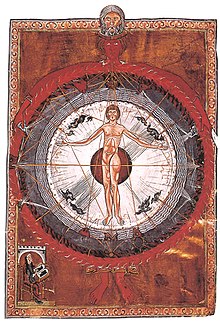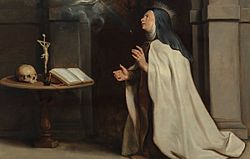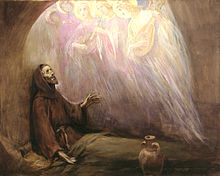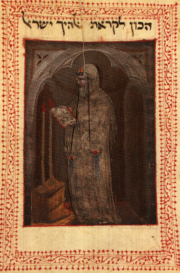User:Osmanvielma/Mysticism

Mysticism is popularly known as becoming one with God or the Absolute, but may refer to any kind of ecstasy or altered state of consciousness which is given a religious or spiritual meaning. It may also refer to the attainment of insight in ultimate or hidden truths, and to human transformation supported by various practices and experiences.
Etymology[edit]
"Mysticism" is derived from the Greek μύω, meaning "I conceal", and its derivative μυστικός, mystikos, meaning 'an initiate'. The verb μύω has received a quite different meaning in the Greek language, where it is still in use. The primary meanings it has are "induct" and "initiate". Secondary meanings include "introduce", "make someone aware of something", "train", "familiarize", "give first experience of something".
Until the sixth century the practice of what is now called mysticism was referred to by the term contemplatio, c.q. theoria. According to Johnston, "[b]oth contemplation and mysticism speak of the eye of love which is looking at, gazing at, aware of divine realities."
Definitions[edit]
According to Peter Moore, the term "mysticism" is "problematic but indispensable." It is a generic term which joins together into one concept separate practices and ideas which developed separately. According to Dupré, "mysticism" has been defined in many ways, and Merkur notes that the definition, or meaning, of the term "mysticism" has changed through the ages. Moore further notes that the term "mysticism" has become a popular label for "anything nebulous, esoteric, occult, or supernatural."
Union with the Divine or Absolute and mystical experience[edit]
Deriving from Neo-Platonism and Henosis, mysticism is popularly known as union with God or the Absolute. In the 13th century the term unio mystica came to be used to refer to the "spiritual marriage," the ecstasy, or rapture, that was experienced when prayer was used "to contemplate both God's omnipresence in the world and God in his essence." In the 19th century, under the influence of Romanticism, this "union" was interpreted as a "religious experience," which provides certainty about God or a transcendental reality.
An influential proponent of this understanding was William James (1842–1910), who stated that "in mystic states we both become one with the Absolute and we become aware of our oneness." William James popularized this use of the term "religious experience" in his The Varieties of Religious Experience, contributing to the interpretation of mysticism as a distinctive experience, comparable to sensory experiences. Religious experiences belonged to the "personal religion," which he considered to be "more fundamental than either theology or ecclesiasticism". He gave a Perennialist interpretation to religious experience, stating that this kind of experience is ultimately uniform in various traditions.
McGinn notes that the term unio mystica, although it has Christian origins, is primarily a modern expression. McGinn argues that "presence" is more accurate than "union", since not all mystics spoke of union with God, and since many visions and miracles were not necessarily related to union. He also argues that we should speak of "consciousness" of God's presence, rather than of "experience", since mystical activity is not simply about the sensation of God as an external object, but more broadly about "new ways of knowing and loving based on states of awareness in which God becomes present in our inner acts."
However, the idea of "union" does not work in all contexts. For example, in Advaita Vedanta, there is only one reality (Brahman) and therefore nothing other than reality to unite with it—Brahman in each person (atman) has always in fact been identical to Brahman all along. Dan Merkur also notes that union with God or the Absolute is a too limited definition, since there are also traditions which aim not at a sense of unity, but of nothingness, such as Pseudo-Dionysius the Areopagite and Meister Eckhart. According to Merkur, Kabbala and Buddhism also emphasize nothingness. Blakemore and Jennett note that "definitions of mysticism [...] are often imprecise." They further note that this kind of interpretation and definition is a recent development which has become the standard definition and understanding.
According to Gelman, "A unitive experience involves a phenomenological de-emphasis, blurring, or eradication of multiplicity, where the cognitive significance of the experience is deemed to lie precisely in that phenomenological feature".
Intuitive insight and enlightenment[edit]
Some authors emphasize that mystical experience involves intuitive understanding of the meaning of existence and of hidden truths, and the resolution of life problems. According to Larson, "mystical experience is an intuitive understanding and realization of the meaning of existence." According to McClenon, mysticism is "the doctrine that special mental states or events allow an understanding of ultimate truths." According to James R. Horne, mystical illumination is "a central visionary experience [...] that results in the resolution of a personal or religious problem.
According to Evelyn Underhill, illumination is a generic English term for the phenomenon of mysticism. The term illumination is derived from the Latin illuminatio, applied to Christian prayer in the 15th century. Comparable Asian terms are bodhi, kensho, and satori in Buddhism, commonly translated as "enlightenment", and vipassana, which all point to cognitive processes of intuition and comprehension.
Spiritual life and re-formation[edit]
Other authors point out that mysticism involves more than "mystical experience." According to Gellmann, the ultimate goal of mysticism is human transformation, not just experiencing mystical or visionary states. According to McGinn, personal transformation is the essential criterion to determine the authenticity of Christian mysticism.

Variations of mysticism[edit]

Based on various definitions of mysticism, namely mysticism as an experience of union or nothingness, mysticism as any kind of an altered state of consciousness which is attributed in a religious way, mysticism as "enlightenment" or insight, and mysticism as a way of transformation, "mysticism" can be found in many cultures and religious traditions, both in folk religion and organized religion. These traditions include practices to induce religious or mystical experiences, but also ethical standards and practices to enhance self-control and integrate the mystical experience into daily life.
Dan Merkur notes, though, that mystical practices are often separated from daily religious practices, and restricted to "religious specialists like monastics, priests, and other renunciates.
Shamanism[edit]

According to Dan Merkur, shamanism may be regarded as a form of mysticism, in which the world of spirits is accessed through religious ecstasy. According to Mircea Eliade shamanism is a "technique of religious ecstasy."
Shamanism involves a practitioner reaching an altered state of consciousness in order to perceive and interact with spirits, and channel transcendental energies into this world. A shaman is a person regarded as having access to, and influence in, the world of benevolent and malevolent spirits, who typically enters into trance during a ritual, and practices divination and healing.
Western mysticism[edit]
Mystery religions[edit]
The Eleusinian Mysteries, (Greek: Ἐλευσίνια Μυστήρια) were annual initiation ceremonies in the cults of the goddesses Demeter and Persephone, held in secret at Eleusis (near Athens) in ancient Greece. The mysteries began in about 1600 B.C. in the Mycenean period and continued for two thousand years, becoming a major festival during the Hellenic era, and later spreading to Rome. Numerous scholars have proposed that the power of the Eleusinian Mysteries came from the kykeon's functioning as an entheogen.
Christian mysticism[edit]
Early Christianity[edit]
The apophatic theology, or "negative theology", of Pseudo-Dionysius the Areopagite (6th c.) exerted a great influence on medieval monastic religiosity, both in the East and (by Latin translation) in the West. Pseudo-Dionysius applied Neoplatonic thought, particularly that of Proclus, to Christian theology.
Orthodox Christianity[edit]
Lua error: Section 'Orthodox Christianity' not found.
Western Europe[edit]

The High Middle Ages saw a flourishing of mystical practice and theorization in western Roman Catholicism, corresponding to the flourishing of new monastic orders, with such figures as Guigo II, Hildegard of Bingen, Bernard of Clairvaux, the Victorines, all coming from different orders, as well as the first real flowering of popular piety among the laypeople.
Western esotericism and modern spirituality[edit]
Many western esoteric traditions and elements of modern spirituality have been regarded as "mysticism," such as Gnosticism, Transcendentalism, Theosophy, the Fourth Way, Martinus, spiritual science, and Neo-Paganism. Modern western spiritually and transpersonal psychology combine western psycho-therapeutic practices with religious practices like meditation to attain a lasting transformation. Nature mysticism is an intense experience of unification with nature or the cosmic totality, which was popular with Romantic writers.
Jewish mysticism[edit]

In the common era, Judaism has had two main kinds of mysticism: Merkabah mysticism and Kabbalah. The former predated the latter, and was focused on visions, particularly those mentioned in the Book of Ezekiel. It gets its name from the Hebrew word meaning "chariot", a reference to Ezekiel's vision of a fiery chariot composed of heavenly beings.
Kabbalah is a set of esoteric teachings meant to explain the relationship between an unchanging, eternal and mysterious Ein Sof (no end) and the mortal and finite universe (his creation). Inside Judaism, it forms the foundations of mystical religious interpretation.
Islamic mysticism[edit]

The consensus is that Islam's inner and mystical dimension is encapsulated in Sufism.
Classical Sufi scholars have defined Sufism as
[A] science whose objective is the reparation of the heart and turning it away from all else but God.
A practitioner of this tradition is nowadays known as a ṣūfī (صُوفِيّ), or, in earlier usage, a dervish. The origin of the word "Sufi" is ambiguous. One understanding is that Sufi means wool-wearer; wool wearers during early Islam were pious ascetics who withdrew from urban life. Another explanation of the word "Sufi" is that it means 'purity'.
Sufi practice includes
- Dhikr, or remembrance (of God), which often takes the form of rhythmic chanting and breathing exercises.
- Sama, which takes the form of music and dance — the whirling dance of the Mevlevi dervishes is a form well known in the West.
- Muraqaba or meditation.
- Visiting holy places, particularly the tombs of Sufi saints, in order to remember death and the greatness of those who have passed.
The aims of Sufism include: the experience of ecstatic states (hal), purification of the heart (qalb), overcoming the lower self (nafs), extinction of the individual personality (fana), communion with God (haqiqa), and higher knowledge (marifat). Some sufic beliefs and practices have been found unorthodox by other Muslims; for instance Mansur al-Hallaj was put to death for blasphemy after uttering the phrase Ana'l Haqq, "I am the Truth" (i.e. God) in a trance.
Notable classical Sufis include Jalaluddin Rumi, Fariduddin Attar, Sultan Bahoo, Sayyed Sadique Ali Husaini, Saadi Shirazi, and Hafez, all major poets in the Persian language. Omar Khayyam, Al-Ghazzali, and Ibn Arabi were renowned scholars. Abdul Qadir Jilani, Moinuddin Chishti, and Bahauddin Naqshband founded major orders, as did Rumi. Rabia Basri was the most prominent female Sufi.
Hinduism[edit]
In Hinduism, various sadhanas (spiritual disciplines) aim at overcoming ignorance (avidya) and transcending one's identification with body, mind, and ego to attain moksha, liberation from the cycle of birth and death. Hinduism has a number of interlinked ascetic traditions and philosophical schools which aim at moksha and the acquisition of higher powers. With the onset of the British colonisation of India, those traditions came to be interpreted in Western terms such as "mysticism", resulting in comparisons with Western terms and practices.
Yoga is a term for physical, mental, and spiritual practices or disciplines which aim to attain a state of permanent peace. Various traditions of yoga are found in Hinduism, Buddhism, and Jainism. The Yoga Sūtras of Patañjali define yoga as "the stilling of the changing states of the mind," culminating in the state of samadhi.
Classical Vedanta gives philosophical interpretations and commentaries of the Upanishads, a vast collection of ancient hymns. At least ten schools of Vedanta are known, of which Advaita Vedanta, Vishishtadvaita, and Dvaita are the best known. Advaita Vedanta, as expounded by Adi Shankara, states that there is no difference between Atman (the world-soul) and Brahman (the divine). The best-known subschool is Kevala Vedanta or mayavada as expounded by Adi Shankara. Advaita Vedanta has acquired a broad acceptance in Indian culture and beyond as the paradigmatic example of Hindu spirituality. In contrast Bhedabheda-Vedanta emphasizes that Atman and Brahman are both the same and not the same, while Dvaita Vedanta states that Atman and God are fundamentally different. In modern times, the Upanishads have been interpreted by Neo-Vedanta as being "mystical".
Various Shaivist, Shakta and Tantric traditions are strongly nondualistic, among them Kashmir Shaivism and Sri Vidya.
Tantra[edit]
Tantra is the name given by scholars to a style of meditation and ritual which arose in India no later than the fifth century AD. Tantra has influenced the Hindu, Bön, Buddhist, and Jain traditions and spread with Buddhism to East and Southeast Asia. Tantric ritual seeks to access the supra-mundane through the mundane, identifying the microcosm with the macrocosm. The Tantric aim is to sublimate (rather than negate) reality. The Tantric practitioner seeks to use prana (energy flowing through the universe, including one's body) to attain goals which may be spiritual, material or both. Tantric practice includes visualisation of deities, mantras and mandalas. It can also include sexual and other (antinomian) practices.
Sant-tradition and Sikhism[edit]
Lua error: Section 'Sant-tradition and Sikhism' not found.
Lua error: Section 'Sant-tradition and Sikhism' not found.
Buddhism[edit]
According to Paul Oliver, a lecturer at Huddersfield University, Buddhism is mystical in the sense that it aims at the identification of the true nature of our self, and live according to it. Buddhism originated in India, sometime between the 6th and 4th centuries BCE, but is now mostly practiced in other countries, where it developed into a number of traditions, the main ones being Therevada, Mahayana, and Vajrayana.
Buddhism aims at liberation from the cycle of rebirth by self-control through meditation and morally just behaviour. Some Buddhist paths aim at a gradual development and transformation of the personality toward Nirvana, like the Theravada stages of enlightenment. Others, like the Japanese Rinzai Zen tradition, emphasize sudden insight, but nevertheless also prescribe intensive training, including meditation and self-restraint.
Although Theravada does not acknowledge the existence of a theistic Absolute, it does postulate Nirvana as a transcendent reality which may be attained. It further stresses transformation of the personality through meditative practice, self-restraint, and morally just behaviour. According to Richard H. Jones, Theravada is a form of mindful extrovertive and introvertive mysticism, in which the conceptual structuring of experiences is weakened, and the ordinary sense of self is weakened. It is best known in the west from the Vipassana movement, a number of branches of modern Theravāda Buddhism from Burma, Cambodia, Laos, Thailand, and Sri Lanka, and includes contemporary American Buddhist teachers such as Joseph Goldstein and Jack Kornfield.
The Yogacara school of Mahayana investigates the workings of the mind, stating that only the mind (citta-mātra) or the representations we cognize (vijñapti-mātra), really exist. In later Buddhist Mahayana thought, which took an idealistic turn, the unmodified mind came to be seen as a pure consciousness, from which everything arises. Vijñapti-mātra, coupled with Buddha-nature or tathagatagarba, has been an influential concept in the subsequent development of Mahayana Buddhism, not only in India, but also in China and Tibet, most notable in the Chán (Zen) and Dzogchen traditions.
Chinese and Japanese Zen is grounded on the Chinese understanding of the Buddha-nature as one true's essence, and the Two truths doctrine as a polarity between relative and Absolute reality. Zen aims at insight into one's true nature, or Buddha-nature, thereby manifesting Absolute reality in the relative reality. In Soto, this Buddha-nature is regarded to be ever-present, and shikan-taza, sitting meditation, is the expression of the already existing Buddhahood. Rinzai-zen emphasises the need for a break-through insight in this Buddha-nature, but also stresses that further practice is needed to deepen the insight and to express it in daily life, as expressed in the Three mysterious Gates, the Four Ways of Knowing of Hakuin, and the Ten Ox-Herding Pictures. The Japanese Zen-scholar D.T. Suzuki noted similarities between Zen-Buddhism and Christian mysticism, especially Meister Eckhart.
The Tibetan Vajrayana tradition is based on Madhyamaka philosophy and Tantra. In deity yoga, visualizations of deities are eventually dissolved, to realize the inherent emptiness of every-'thing' that exists. Dzogchen, which is being taught in both the Tibetan Buddhist Nyingma school and the Bön tradition, focuses on direct insight into our real nature. It holds that "mind-nature" is manifested when one is enlightened, being nonconceptually aware (rigpa, "open presence") of one's nature, "a recognition of one's beginningless nature." Mahamudra has similarities with Dzogchen, emphasizing the meditational approach to insight and liberation.
Taoism[edit]
Taoist philosophy is centered on the Tao, usually translated "Way", an ineffable cosmic principle. The contrasting yet interdependent concepts of yin and yang also symbolise harmony, with Taoist scriptures often emphasising the Yin virtues of femininity, passivity and yieldingness. Taoist practice includes exercises and rituals aimed at manipulating the life force Qi, and obtaining health and longevity. These have been elaborated into practices such as Tai chi, which are well known in the west.
The Secularization of Mysticism[edit]
Lua error: Section 'The Secularization of Mysticism' not found.
Neurological research[edit]
The temporal lobe seems to be involved in mystical experiences, and in the change in personality that may result from such experiences. It generates the feeling of "I," and gives a feeling of familiarity or strangeness to the perceptions of the senses. There is a long-standing notion that epilepsy and religion are linked, and some religious figures may have had temporal lobe epilepsy (TLE).
Notes[edit]
- Note that Parmenides' "way of truth" may also be translated as "way of conviction." Parmenides (fl. late sixth or early fifth century BC), in his poem On Nature, gives an account of a revelation on two ways of inquiry. "The way of conviction" explores Being, true reality ("what-is"), which is "What is ungenerated and deathless,/whole and uniform, and still and perfect." "The way of opinion" is the world of appearances, in which one's sensory faculties lead to conceptions which are false and deceitful. Cook's translation "way of conviction" is rendered by other translators as "way of truth."
- The term "mystical experience" has become synonymous with the terms "religious experience", spiritual experience and sacred experience.
- William James: "This is the everlasting and triumphant mystical tradition, hardly altered by differences of clime or creed. In Hinduism, in Neoplatonism, in Sufism, in Christian mysticism, in Whitmanism, we find the same recurring note, so that there is about mystical utterances an eternal unanimity which ought to make a critic stop and think, and which bring it about that the mystical classics have, as has been said, neither birthday nor native land."
- Blakemore and Jennett: "Mysticism is frequently defined as an experience of direct communion with God, or union with the Absolute, but definitions of mysticism (a relatively modern term) are often imprecise and usually rely on the presuppositions of the modern study of mysticism — namely, that mystical experiences involve a set of intense and usually individual and private psychological states [...] Furthermore, mysticism is a phenomenon said to be found in all major religious traditions. Blakemore and Jennett add: "The common assumption that all mystical experiences, whatever their context, are the same cannot, of course, be demonstrated." They also state: "Some have placed a particular emphasis on certain altered states, such as visions, trances, levitations, locutions, raptures, and ecstasies, many of which are altered bodily states. Margery Kempe's tears and Teresa of Avila's ecstasies are famous examples of such mystical phenomena. But many mystics have insisted that while these experiences may be a part of the mystical state, they are not the essence of mystical experience, and some, such as Origen, Meister Eckhart, and John of the Cross, have been hostile to such psycho-physical phenomena. Rather, the essence of the mystical experience is the encounter between God and the human being, the Creator and creature; this is a union which leads the human being to an ‘absorption’ or loss of individual personality. It is a movement of the heart, as the individual seeks to surrender itself to ultimate Reality; it is thus about being rather than knowing. For some mystics, such as Teresa of Avila, phenomena such as visions, locutions, raptures, and so forth are by-products of, or accessories to, the full mystical experience, which the soul may not yet be strong enough to receive. Hence these altered states are seen to occur in those at an early stage in their spiritual lives, although ultimately only those who are called to achieve full union with God will do so."
- Gelman: "Examples are experiences of the oneness of all of nature, “union” with God, as in Christian mysticism, (see section 2.2.1), the Hindu experience that Atman is Brahman (that the self/soul is identical with the eternal, absolute being), the Buddhist unconstructed experience, and “monistic” experiences, devoid of all multiplicity."
Compare Plotinus, who argued that The One is radically simple, and does not even have self-knowledge, since self-knowledge would imply multiplicity. Nevertheless, Plotinus does urge for a search for the Absolute, turning inward and becoming aware of the "presence of the intellect in the human soul," initiating an ascent of the soul by abstraction or "taking away," culminating in a sudden appearance of the One.
- Merkur: "Mysticism is the practice of religious ecstasies (religious experiences during alternate states of consciousness), together with whatever ideologies, ethics, rites, myths, legends, and magic may be related to them."
- Parsons: "...episodic experience and mysticism as a process that, though surely punctuated by moments of visionary, unitive, and transformative encounters, is ultimately inseparable from its embodied relation to a total religious matrix: liturgy, scripture, worship, virtues, theology, rituals, practice and the arts.
- Larson: "A mystical experience is an intuitive understanding and realization of the meaning of existence – an intuitive understanding and realization which is intense, integrating, self-authenticating, liberating – i.e., providing a sense of release from ordinary self-awareness – and subsequently determinative – i.e., a primary criterion – for interpreting all other experience whether cognitive, conative, or affective."
- McClenon: "The doctrine that special mental states or events allow an understanding of ultimate truths. Although it is difficult to differentiate which forms of experience allow such understandings, mental episodes supporting belief in "other kinds of reality" are often labeled mystical [...] Mysticism tends to refer to experiences supporting belief in a cosmic unity rather than the advocation of a particular religious ideology."
- Horne: "Mystical illumination is interpreted as a central visionary experience in a psychological and behavioural process that results in the resolution of a personal or religious problem. This factual, minimal interpretation depicts mysticism as an extreme and intense form of the insight seeking process that goes in activities such as solving theoretical problems or developing new inventions.
- Gellman: "Typically, mystics, theistic or not, see their mystical experience as part of a larger undertaking aimed at human transformation (See, for example, Teresa of Avila, Life, Chapter 19) and not as the terminus of their efforts. Thus, in general, ‘mysticism’ would best be thought of as a constellation of distinctive practices, discourses, texts, institutions, traditions, and experiences aimed at human transformation, variously defined in different traditions." According to Evelyn Underhill, mysticism is "the science or art of the spiritual life."
- Underhill: "One of the most abused words in the English language, it has been used in different and often mutually exclusive senses by religion, poetry, and philosophy: has been claimed as an excuse for every kind of occultism, for dilute transcendentalism, vapid symbolism, religious or aesthetic sentimentality, and bad metaphysics. on the other hand, it has been freely employed as a term of contempt by those who have criticized these things. It is much to be hoped that it may be restored sooner or later to its old meaning, as the science or art of the spiritual life."
- According to Waaijman, the traditional meaning of spirituality is a process of re-formation which "aims to recover the original shape of man, the image of God. To accomplish this, the re-formation is oriented at a mold, which represents the original shape: in Judaism the Torah, in Christianity Christ, in Buddhism Buddha, in the Islam Muhammad. "Waaijman uses the word "omvorming", "to change the form". Different translations are possible: transformation, re-formation, trans-mutation. Waaijman points out that "spirituality" is only one term of a range of words which denote the praxis of spirituality. Some other terms are "Hasidism, contemplation, kabbala, asceticism, mysticism, perfection, devotion and piety".
- McGinn: "This is why the only test that Christianity has known for determining the authenticity of a mystic and her or his message has been that of personal transformation, both on the mystic's part and—especially—on the part of those whom the mystic has affected.
- Metropolitan Hierotheos Vlachos: "Noetic prayer is the first stage of theoria."
- Theophan the Recluse: "The contemplative mind sees God, in so far as this is possible for man."
- Metropolitan Hierotheos Vlachos: "This is what Saint Symeon the New Theologian teaches. In his poems, proclaims over and over that, while beholding the uncreated Light, the deified man acquires the Revelation of God the Trinity. Being in "theoria" (vision of God), the saints do not confuse the hypostatic attributes. The fact that the Latin tradition came to the point of confusing these hypostatic attributes and teaching that the Holy Spirit proceeds from the Son also, shows the non-existence of empirical theology for them. Latin tradition speaks also of created grace, a fact which suggests that there is no experience of the grace of God. For, when man obtains the experience of God, then he comes to understand well that this grace is uncreated. Without this experience there can be no genuine 'therapeutic tradition.'"
- Catholic Encyclopedia: "But it was Simeon, "the new theologian" (c. 1025-c. 1092; see Krumbacher, op. cit., 152–154), a monk of Studion, the "greatest mystic of the Greek Church" (loc. cit.), who evolved the quietist theory so elaborately that he may be called the father of Hesychasm. For the union with God in contemplation (which is the highest object of our life) he required a regular system of spiritual education beginning with baptism and passing through regulated exercises of penance and asceticism under the guidance of a director. But he had not conceived the grossly magic practices of the later Hesychasts; his ideal is still enormously more philosophical than theirs."
- Yogacara postulates an advaya (nonduality) of grahaka ("grasping," cognition) and gradya (the "grasped," cognitum). In Yogacara-thought, cognition is a modification of the base-consciousness, alaya-vijnana. According to the Lankavatara Sutra and the schools of Chan/Zen Buddhism, this unmodified mind is identical with the tathagata-garbha, the "womb of Buddhahood," or Buddha-nature, the nucleus of Buddhahood inherent in everyone. Both denoye the potentiality of attaining Buddhahood. In the Lankavatara-interpretation, tathagata-garbha as a potentiality turned into a metaphysical Absolute reality which had to be realised.
- Extending to physical immortality: the Taoist pantheon includes Xian, or immortals.
